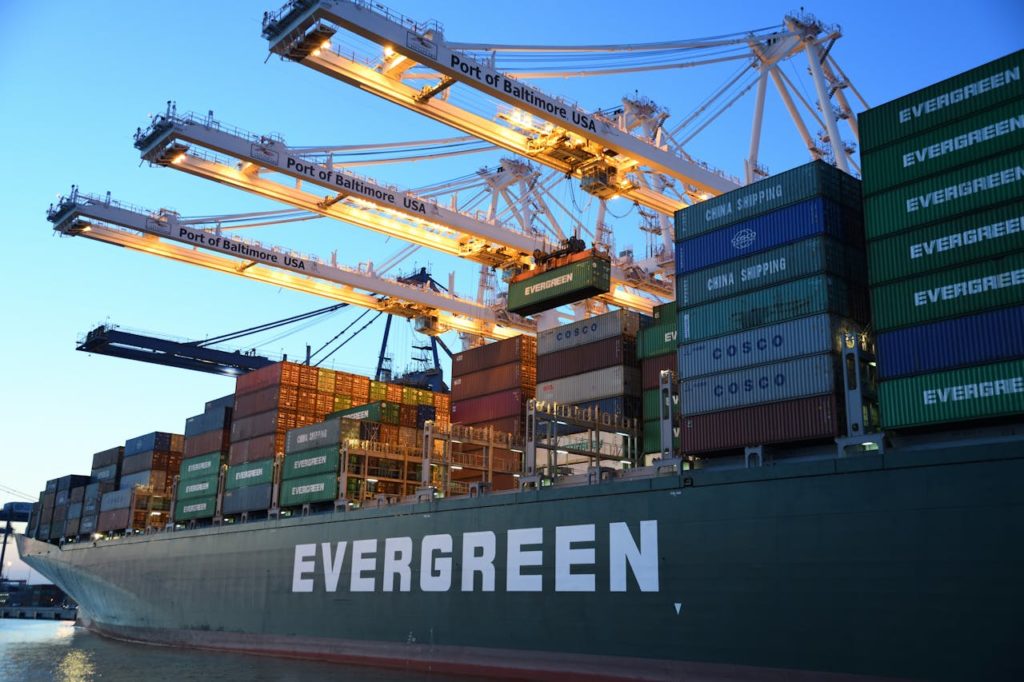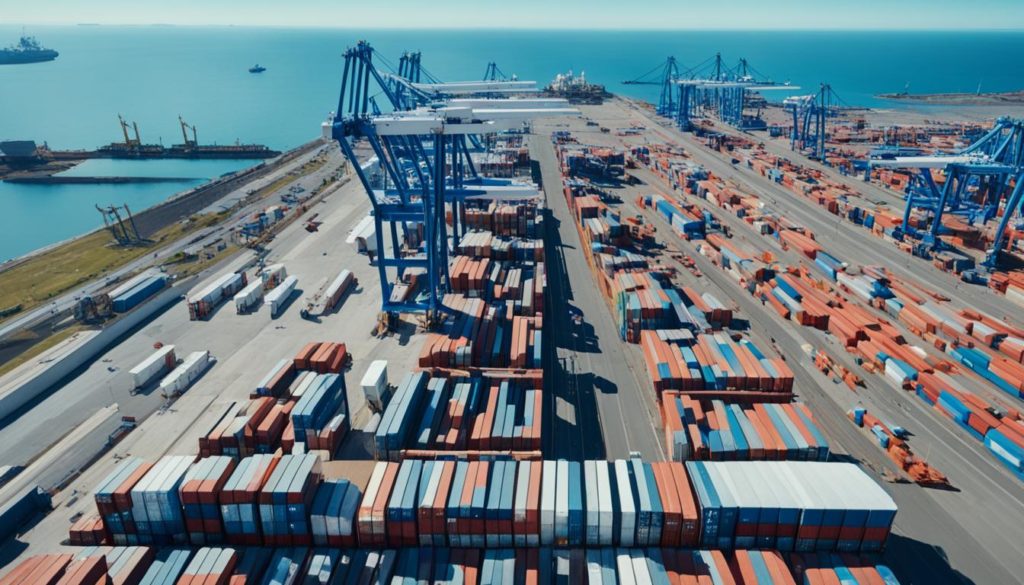Are you struggling to optimize your door to door container shipping process and ensure efficient international freight shipping? Do you want to uncover the key essentials of streamlined logistics container shipping?
Well, you’re not alone. Many businesses face challenges when it comes to effectively managing their supply chain and shipping operations, especially when shipping Europe to USA. However, by understanding the essentials and implementing the right strategies, you can transform your supply chain into a well-oiled machine.
What you need to know before we get started?
1. Global container shipping accounted for $11.9 trillion worth of goods transported in 2020.
2. The top container shipping company, Maersk, alone transported approximately 11 million containers in 2020.
3. Container shipping rates have seen an average annual increase of 4-5% over the past decade.
In this article, we’ll explore the importance of efficient supply chain management and dive into the key elements that can streamline your shipping processes. From understanding supply chain visibility to implementing technology-driven shipment management controls, we’ll provide you with the insights and strategies you need to optimize your container shipping operations.
So, let’s get started!
How to Streamline Your Supply Chain & Understand the Essentials of Efficient Shipping?
| Aspect | What Is It? |
|---|---|
| Inventory Management 📦 | Optimizing stock levels and storage efficiency |
| Transportation 🚚 | Efficient movement of goods from supplier to customer |
| Warehousing 🏭 | Effective storage solutions for inventory |
| Supplier Relationships 🤝 | Building strong partnerships for reliability |
| Technology Integration 💻 | Utilizing software and automation for tracking and management |
| Demand Forecasting 📈 | Anticipating customer needs for accurate planning |
| Order Fulfillment 📦✈️ | Timely processing and delivery of customer orders |
| Quality Control ✅ | Ensuring products meet standards before shipment |
The Importance of Supply Chain Visibility for Efficient Shipping
Lack of supply chain visibility is the biggest challenge supply chain executives face. In today’s fast-paced and interconnected global market, real-time visibility is crucial for effective and efficient shipping operations. Without a clear view of logistics data and supply chain analytics, businesses can encounter inventory management issues and higher costs.

Supply chain awareness is a term that refers to tracking and monitoring the movement of raw materials, data and money across the supply chain in real time; it gives companies a complete understanding of their supply chains and helps them find weak points before they become problems.
Real-time visibility can be achieved through fulfillment technology: for example, businesses can now track their inventory as well as keep everything in view at all times. This means making informed decisions about where necessary because it allows one not only to react quickly when other links go wrong but also save on potential disruptions. Apart from this, such systems help optimize stock levels by highlighting areas needing improvement while minimizing excess stocks elsewhere.
Without doubt, supply chain visibility is key to effective management of risk within an organization’s overall strategies towards this end being best served by taking proactive measures instead waiting until after things have gone awry. A company with up-to-the-minute information can monitor shipments progress or lack thereof; measure partner performance against agreed service levels (SLAs); manage volumes relative safety stocks among many more.
Furthermore, different people within a given supply chain often work separately from each other hence coordination between them becomes difficult without good communication channels such as those provided by enhancing supply chain visibility in business practices. It may involve sharing relevant details between suppliers and customers which facilitates better co-ordination leading not only improved customer service levels but also higher satisfaction ratings from these parties involved.
All in all, the importance of having efficient shipping operations cannot be underestimated due mainly so because without which companies will not only be able meet their respective needs but also improve on customer satisfaction thereby earning goodwill points necessary success during today’s dynamic markets where gaining competitive advantage is becoming increasingly difficult unless backed up with proper investments like having robust systems capable adapting changing environments that are associated with globalisation effects
The National Logistics Policy and its Implications for Efficient Shipping
India’s National Logistics Policy plays a pivotal role in revolutionizing the logistics and supply chain sector. With a focus on enhancing efficiency, this policy encompasses critical aspects such as logistics infrastructure, transportation networks, digitization, policy reforms, and skill development.
The National Logistics Policy aims to address the challenges faced by the supply chain industry, including high logistics costs and the need for improved global trade competitiveness. By investing in infrastructure development, the policy strives to optimize transportation networks, reducing bottlenecks and enhancing connectivity.
Promoting Digitization and Policy Reforms
The policy recognizes the importance of digitization in streamlining operations, improving transparency, and optimizing resource allocation. By leveraging digital technologies, businesses can achieve real-time visibility, track shipments, and analyze data to make informed decisions.
In addition to digitization, the National Logistics Policy advocates for policy reforms that remove regulatory hurdles and simplify processes. Synchronous coordination between different stakeholders, including customs authorities and logistics service providers, helps expedite clearance and reduce delays.
Driving Employment Opportunities and Sustainability
The National Logistics Policy not only aims to enhance efficiency but also fosters employment opportunities in the logistics sector. As the industry grows and seeks to meet the demands of a rapidly evolving global economy, skilled professionals will be in high demand. The policy emphasizes skill development programs to create employment opportunities and ensure a competent workforce.
Furthermore, the policy encourages sustainable practices and green logistics to minimize the environmental impact of the supply chain sector. By promoting the adoption of sustainable transportation modes and optimizing routes, the policy aims to reduce carbon emissions and contribute to a greener future.

The Implications for Businesses
The National Logistics Policy has profound implications for businesses operating in the logistics and supply chain sector. By reducing logistics costs through infrastructure development and efficient transportation networks, businesses can improve their profit margins and remain competitive in the global market.
The emphasis on digitization and policy reforms enables businesses to streamline their operations, optimize resource utilization, and enhance overall efficiency. This, in turn, fosters improved global trade competitiveness and innovation.
Furthermore, the emphasis on skill development creates opportunities for businesses to attract and retain a skilled workforce, ensuring their continued success in an increasingly complex and competitive environment.
| Implications for Businesses: | |
|---|---|
| Reduced logistics costs | Enhanced efficiency |
| Improved global trade competitiveness | Innovation |
| Employment opportunities in the logistics sector | |
The Role of Technology in Shipment Management
Shipment management involves various critical controls to ensure smooth operations and efficient logistics. These controls include carrier selection, route optimization, visibility and tracking, documentation and compliance, and cost control and audit. In today’s digital age, technology plays a crucial role in enhancing and optimizing shipment management processes. Let’s explore how technology enables businesses to streamline their logistics operations and drive greater efficiency.
Automation for Reduced Human Error
Technology-driven automation has revolutionized the way shipments are managed.
Businesses can significantly reduce human error and enhance cost control and audit by automating repetitive manual tasks, such as data entry and paperwork. Automation also frees up staff to focus on more strategic aspects of shipment management, leading to improved overall efficiency.
Real-Time Visibility and Tracking
One of the key benefits of technology in shipment management is real-time visibility and tracking. Through the use of tracking technologies and Internet of Things (IoT) devices, businesses can monitor their shipments at every stage of the supply chain. This enables proactive management of delays, ensuring timely deliveries and improved customer satisfaction. Efficient visibility and tracking contributes to better carrier selection and route optimization as well.
Data Analytics for Performance Insights
Data analytics plays a vital role in optimizing shipment management.
Businesses can gain valuable insights into their performance by analyzing data on shipping patterns, delivery times, and other relevant metrics. This allows them to identify areas for improvement and make data-driven decisions to enhance cost control and audit and overall efficiency. Data analytics also helps businesses identify trends and forecast demand for better route optimization.
Collaboration Tools for Effective Communication
Effective communication among stakeholders is crucial for successful shipment management. Technology provides collaboration tools that facilitate seamless communication between carriers, suppliers, and customers. These tools enable real-time sharing of information, resolving potential issues swiftly, and ensuring compliance with documentation and compliance requirements. Enhanced communication leads to smoother logistics operations and improved shipment management.
Image for Reference: The Role of Technology in Shipment Management
| Benefits of Technology in Shipment Management |
|---|
| Reduces human error through automation |
| Provides real-time visibility and tracking |
| Enables data-driven decision making with analytics |
| Facilitates effective communication among stakeholders |
Implementing Technology for Effective Shipment Management
When it comes to managing shipments efficiently, adopting a technology-driven approach is key. By harnessing the power of innovative tools and systems, businesses can streamline their processes, optimize operations, and ensure customer satisfaction. Here are the essential steps to implement technology for effective shipment management:
Assess Your Needs
The first step is to thoroughly assess your company’s specific requirements and challenges in shipment management. Identify the pain points, such as communication gaps, manual errors, or delays, that can be addressed with technology-driven solutions. This assessment will help you determine the right tools and systems that align with your business goals.
Select the Right Technology
Once you understand your needs, it’s time to explore the various technology options available in the market. One of the most effective tools for efficient shipment management is a Transportation Management System (TMS). A TMS allows you to automate and optimize key processes such as carrier selection, route planning, and freight tracking. Look for a TMS that offers robust features and integrates well with your existing systems.
Integrate with Existing Systems
Integration is crucial for seamless operations and data flow. Ensure that the technology you choose allows for easy integration with your existing systems, such as your Enterprise Resource Planning (ERP) software, warehouse management system, or customer relationship management system. This integration will enable cross-functional visibility and streamline information exchange, minimizing manual data entry and reducing errors.
Provide Training for Your Team
Implementing new technology requires proper training and change management to ensure that your team can effectively utilize the tools at their disposal. Offer comprehensive training sessions and resources to familiarize your employees with the features and functionalities of the chosen technology. This training will empower your team to leverage the system’s capabilities and maximize its potential for efficient shipment management.
Monitor and Adjust Performance
Once the technology is implemented, don’t forget the importance of continuous monitoring and performance evaluation. Establish key performance indicators (KPIs) to measure the effectiveness of the technology-driven approach. Regularly review these metrics and identify areas for improvement. Adjusting the technology, processes, or training as needed will ensure you constantly enhance your shipment management practices.
Implementing a technology-driven approach in shipment management empowers businesses to optimize operations, reduce costs, and enhance customer satisfaction. By following these steps, you can easily leverage modern technology’s benefits and navigate the complex logistics landscape.
| Key Benefits of Implementing Technology for Effective Shipment Management |
|---|
| – Streamlined processes |
| – Improved operational efficiency |
| – Cost savings through optimized routes and reduced manual errors |
| – Enhanced customer satisfaction with timely and accurate deliveries |
| – Better inventory management through real-time visibility |
Benefits of Effective Shipment Management for Businesses
Effective shipment management offers numerous advantages to businesses, including operational efficiency, cost savings, improved customer satisfaction, and enhanced inventory management. By implementing streamlined processes and leveraging the right technologies, businesses can optimize their shipping operations and achieve greater success.
Operational Efficiency
Efficient shipment management allows businesses to streamline their processes, resulting in smoother operations and enhanced productivity. By optimizing routes, utilizing real-time tracking, and automating various tasks, businesses can minimize delays, reduce errors, and improve overall efficiency. This increased operational efficiency enables them to meet customer demands more effectively while ensuring timely deliveries.
Cost Savings
Implementing effective shipment management strategies can lead to significant cost savings for businesses. Optimized routes and transportation planning help minimize fuel consumption and reduce transportation expenses. Accurate billing and invoicing processes also help eliminate errors and prevent financial losses. By controlling costs through efficient shipment management, businesses can allocate their resources more effectively and improve their bottom line.
Improved Customer Satisfaction
Timely and accurate deliveries are crucial for customer satisfaction. Effective shipment management enables businesses to meet customer expectations by ensuring on-time deliveries. Real-time visibility and tracking capabilities allow businesses to provide accurate delivery estimates, proactively manage delays, and promptly address any issues that may arise. By consistently meeting customer demands and providing reliable shipping services, businesses can cultivate customer loyalty and maintain high levels of satisfaction.
Enhanced Inventory Management
Efficient shipment management plays a vital role in improving inventory management practices. By closely tracking and monitoring shipments, businesses can gain better visibility into their inventory levels and accurately plan for restocking. This proactive approach helps reduce stockouts, minimize excess inventory, and optimize inventory turnover rates. Effective inventory management leads to improved cash flow, reduced holding costs, and increased business profitability.
Implementing effective shipment management practices can bring immense benefits to businesses, ranging from operational efficiency and cost savings to customer satisfaction and improved inventory management. By embracing the right technologies, optimizing processes, and prioritizing customer needs, businesses can gain a competitive edge in today’s dynamic marketplace.
Conclusion
Better management of deliveries is vital when it comes to improving the efficiency of supply chains and satisfying clients. By using technology, organizations can automate tasks; therefore gaining the ability to see in real-time and optimize their operations by analyzing data. What this means is that setting up controls for managing technologically-driven shipments enables firms to simplify all its processes hence lowering costs and increasing customer satisfaction.
For enterprises to remain relevant in a world where logistics is always changing, they must stay updated on technological advancements. Businesses should embrace new ideas together with tools that will help them fit into new market trends while still meeting customers’ expectations as well running their operations effectively.
Efficient resource utilization is one of the benefits that can be realized through proper technology-based management of shipments by businesses which ensures smooth flow goods. This eliminates delays and enhances supply chain performance leading thus cutting down operational costs as well as making clients happy. Therefore, long-term investment in technologies used for controlling the movement of items from one place or person to another may serve as a milestone toward success for any enterprise.

